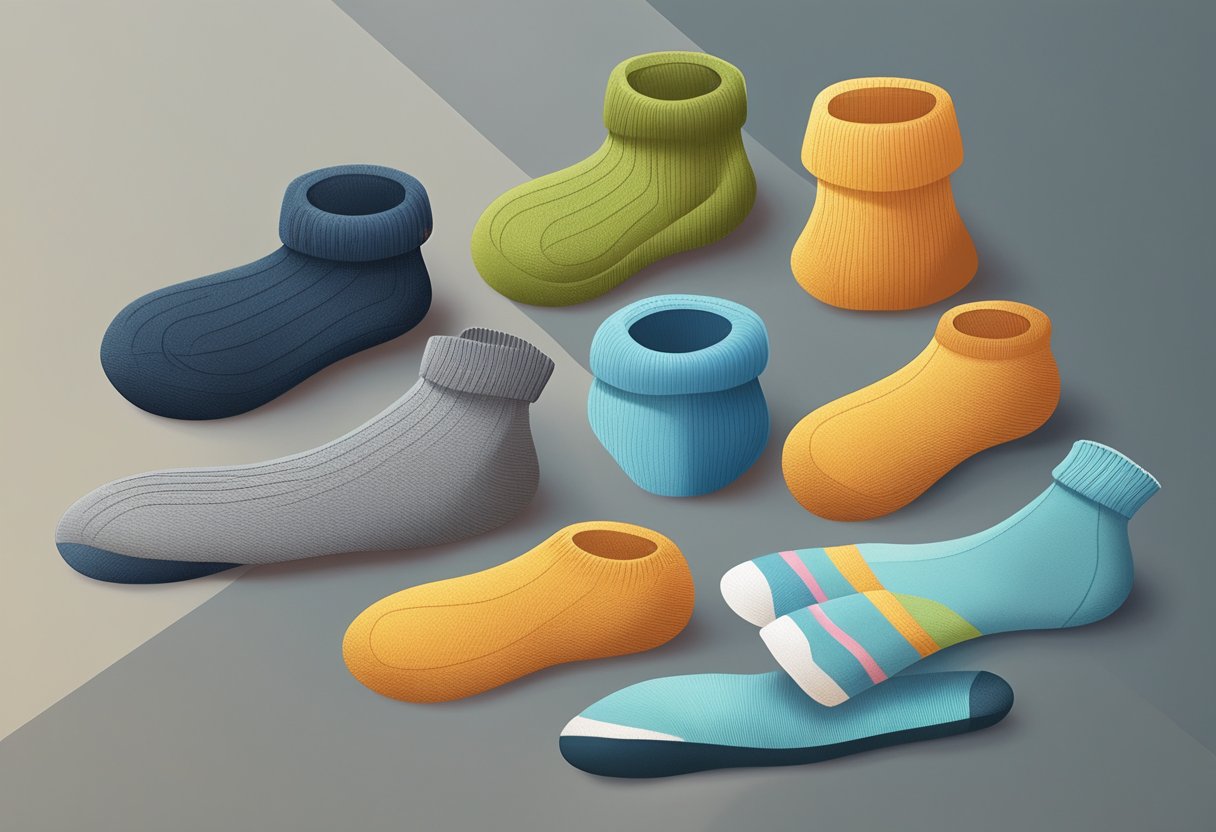Types Of Socks
Socks are an essential part of everyday attire. They not only keep your feet warm and comfortable but also serve as a fashion statement. With so many types of socks available in the market, it can be challenging to choose the right pair for the right occasion. This article aims to provide a comprehensive guide to the different types of socks, their materials, lengths, styles, functions, and designs to help you make an informed decision when selecting the perfect pair of socks.
When it comes to sock materials, there are various options to choose from, including cotton, wool, nylon, polyester, and spandex. The choice of material depends on the level of comfort, breathability, and durability required. Additionally, the length and style of socks vary from ankle-length to knee-length, and from formal to casual wear. Understanding the function and occasion of the socks is also crucial in selecting the right pair. For example, athletic socks are designed to provide extra cushioning and support, while dress socks are designed to complement formal wear.
Choosing the right socks can be a daunting task, but with the right information, it can be a breeze. This article provides a comprehensive guide to help you choose the right socks for the right occasion. From sock materials and comfort to sock lengths and styles, function, and occasion, and sock design and fashion, this article covers all the essential aspects of socks.
Key Takeaways
- Sock materials and comfort, sock lengths and styles, function, and occasion, and sock design and fashion are essential factors to consider when choosing the right pair of socks.
- Understanding the purpose of the socks is crucial in selecting the right pair.
- Proper care and maintenance of socks can extend their lifespan and ensure maximum comfort.
Sock Materials and Comfort

When it comes to choosing the perfect pair of socks, understanding the composition of socks is essential. Socks are made of various materials, including natural fibers and synthetic materials. In this section, we will explore the different types of sock materials and their comfort levels.
Natural Fibers
Natural fibers are the most common materials used in making socks. They include wool, cotton, cashmere, and silk.
Wool socks are a popular choice for colder climates because they provide excellent insulation. Wool is a natural fiber that can absorb moisture, keeping the feet dry and comfortable.
Cotton socks are lightweight and breathable, making them ideal for warmer climates. They are also absorbent, which helps to keep feet dry. However, cotton socks are not as durable as wool socks.
Cashmere socks are soft and luxurious, providing excellent warmth and comfort. They are also lightweight and breathable, making them perfect for year-round wear.
Silk socks are lightweight and comfortable, providing excellent insulation in colder climates. They are also moisture-wicking, which helps to keep feet dry.
Synthetic Materials
Synthetic materials are becoming increasingly popular in sock manufacturing. They include nylon, polyester, and acrylic.
Nylon socks are durable and lightweight, making them ideal for athletic activities. They are also moisture-wicking, which helps to keep feet dry.
Polyester socks are soft and comfortable, providing excellent insulation in colder climates. They are also moisture-wicking, which helps to keep feet dry.
Acrylic socks are lightweight and breathable, making them ideal for warmer climates. They are also moisture-wicking, which helps to keep feet dry.
In conclusion, understanding the different types of sock materials is essential in choosing the perfect pair of socks. Natural fibers provide excellent insulation and comfort, while synthetic materials provide durability and moisture-wicking properties. It is essential to choose the right material based on the climate and activity level to ensure maximum comfort.
Sock Lengths and Styles
When it comes to socks, there are a variety of lengths and styles to choose from. From ankle socks to thigh-highs, each style serves a different purpose and can complement different outfits. In this section, we’ll take a closer look at the most common sock lengths and styles.
Ankle and No-Show Socks
Ankle and no-show socks are the shortest sock styles available. Ankle socks typically cover the ankle bone, while no-show socks sit just below it. These styles are perfect for wearing with sneakers or low-cut shoes, as they provide coverage without being visible above the shoe. They’re also great for warmer weather or when you don’t want your socks to be visible.
Crew and Mid-Calf Socks
Crew and mid-calf socks are the most common sock lengths. Crew socks typically come up to the middle of the calf, while mid-calf socks come up slightly higher. These styles are versatile and can be worn with a variety of shoes, from sneakers to dress shoes. They’re also great for cooler weather or when you want a little more coverage.
Knee-High and Thigh-High Socks
Knee-high and thigh-high socks are the longest sock styles available. Knee-high socks come up to just below the knee, while thigh-high socks come up to the mid-thigh. These styles are often worn for fashion purposes, as they can add a unique touch to an outfit. Knee-high socks are also popular for sports like soccer or field hockey, as they can provide extra shin protection.
Overall, there are a variety of sock lengths and styles to choose from. Whether you’re looking for something short and discreet or long and fashionable, there’s a sock style for every occasion.
Function and Occasion
Socks serve a variety of functions and are designed for different occasions. Understanding the purpose of socks and selecting the right type can make a significant difference in foot comfort and overall health.
Athletic and Sports Socks
Athletic and sports socks are designed for physical activities. They offer extra cushioning and support, helping to prevent blisters and injuries. Compression socks are also popular among athletes, as they improve blood flow to the feet and legs, reducing fatigue and aiding in recovery.
Dress and Casual Socks
Dress and casual socks are designed for everyday wear and come in a variety of styles and materials. Dress socks are typically made of thin, lightweight materials and are designed to be worn with dress shoes. Casual socks are thicker and can be made of materials such as cotton, wool, or synthetic blends. They are designed to be worn with casual shoes such as sneakers or boots.
Specialty Socks
Specialty socks are designed for specific functions or occasions. Liner socks are ultra-low and are ideal for when you don’t want your socks to show. They are nearly invisible when you wear shoes, making them perfect for dress shoes or flats. Diabetic socks are designed to reduce pressure on the feet, helping to prevent injury and promote circulation. Thermal socks are designed to keep the feet warm in cold weather. Waterproof socks are ideal for outdoor activities such as hiking or fishing, as they keep the feet dry and comfortable.
Overall, selecting the right type of sock for the occasion can make a significant difference in foot comfort and overall health. It is important to consider factors such as function, occasion, protection, and style when selecting socks.
Sock Design and Fashion
When it comes to socks, there are plenty of design and fashion options to choose from. Socks are not just a functional item to keep your feet warm and dry, but also a fashion statement that can showcase your personality. In this section, we will explore some of the popular sock designs and fashion trends.
Patterns and Colors
Socks come in a wide range of colors and patterns, from solid colors to bold prints. Choosing the right color and pattern can add a touch of personality to your outfit. For example, if you want to add a pop of color to your outfit, you can opt for bright-colored socks. On the other hand, if you want to keep it simple, you can go for neutral colors like black, white, or gray.
In addition to colors, patterns are another way to make a fashion statement with your socks. Some popular patterns include stripes, polka dots, and argyle. If you’re feeling adventurous, you can even try out fun and quirky patterns like animal prints or food prints.
Innovative Features
Sock design has come a long way, and there are many innovative features that you can find in socks today. For example, some socks are designed with extra cushioning in the heel and toe areas, providing added comfort and support. Other socks are made with moisture-wicking materials that can keep your feet dry and cool, even during intense physical activities.
Fishnet and fence net socks are also a popular fashion trend, especially among women. These socks are made with a unique net-like pattern that can add a touch of edginess to any outfit. They are often worn with high heels or boots to create a bold and daring look.
In conclusion, socks are more than just a functional item, they can also be a fashion statement. With a wide range of designs and features available, you can choose socks that showcase your personality and style.
Choosing the Right Socks
When it comes to choosing the right socks, there are a few things to keep in mind. Socks are not just an accessory, but an important part of your wardrobe that can affect your comfort and performance. Here are some factors to consider when choosing socks.
By Shoe Type
Different types of shoes require different types of socks. For example, athletic shoes require socks that provide cushioning and support, while dress shoes require thinner, more breathable socks. Boot socks are designed to be worn with boots and provide extra warmth and cushioning. Chelsea boots, on the other hand, require socks that are thin and sit lower on the ankle.
By Activity
The activity you will be engaging in also plays a role in choosing the right socks. For athletic activities, socks that provide cushioning and support are important to prevent blisters and improve performance. For formal occasions, thinner, more breathable socks that match the color of the outfit are appropriate.
Sizing and Fit
Sizing and fit are crucial when it comes to socks. Socks that are too small can be uncomfortable and restrict circulation, while socks that are too large can bunch up and cause blisters. It is important to choose socks that fit snugly, but not too tight. It is also important to consider the length of the socks. Crew socks are the most versatile and can be worn with most shoe types, while ankle socks are ideal for low-cut shoes.
In conclusion, choosing the right socks depends on various factors such as shoe type, activity, and sizing and fit. By considering these factors, one can ensure comfort, performance, and style.
Care and Maintenance FAQs
Taking care of your socks is important to ensure that they last long and remain comfortable to wear. Here are some frequently asked questions about sock care and maintenance:
How often should I wash my socks?
The frequency of washing your socks depends on factors such as the material of the sock, how often you wear them, and how much you sweat. As a general rule, it is recommended to wash socks after every use. This helps to prevent the buildup of bacteria and fungi, which can cause foot odor and infections.
How should I wash my socks?
The best way to wash your socks is to follow the care instructions on the label. Most socks can be machine washed in cold or warm water and tumble dried on low heat. However, some materials such as wool or silk may require hand washing or air drying. It is also important to avoid using bleach or fabric softeners, as these can damage the fibers of the sock.
How should I store my socks?
Storing your socks properly can help to maintain their shape and prevent them from getting lost or damaged. One way to store socks is to fold them in half, matching the heels and toes, and then folding them in half again to create a small bundle. You can then store the bundle in a drawer or bin. Another way is to lay the socks flat on a surface, with the toes pointing up, and then fold the top of the socks down towards the toes.
How can I prevent my socks from losing their shape?
To prevent your socks from losing their shape, avoid stretching them out when putting them on or taking them off. It is also important to avoid hanging them up to dry, as this can cause them to stretch out of shape. Instead, lay them flat to dry or tumble dry on low heat.
Can I wear socks as an outer garment?
While socks are traditionally worn as an undergarment, they can also be worn as an outer garment for fashion purposes. However, it is important to choose socks that are designed for this purpose, such as knee-high or thigh-high socks. It is also important to consider the outfit and occasion when wearing socks as an outer garment, as they may not be appropriate for all situations.






